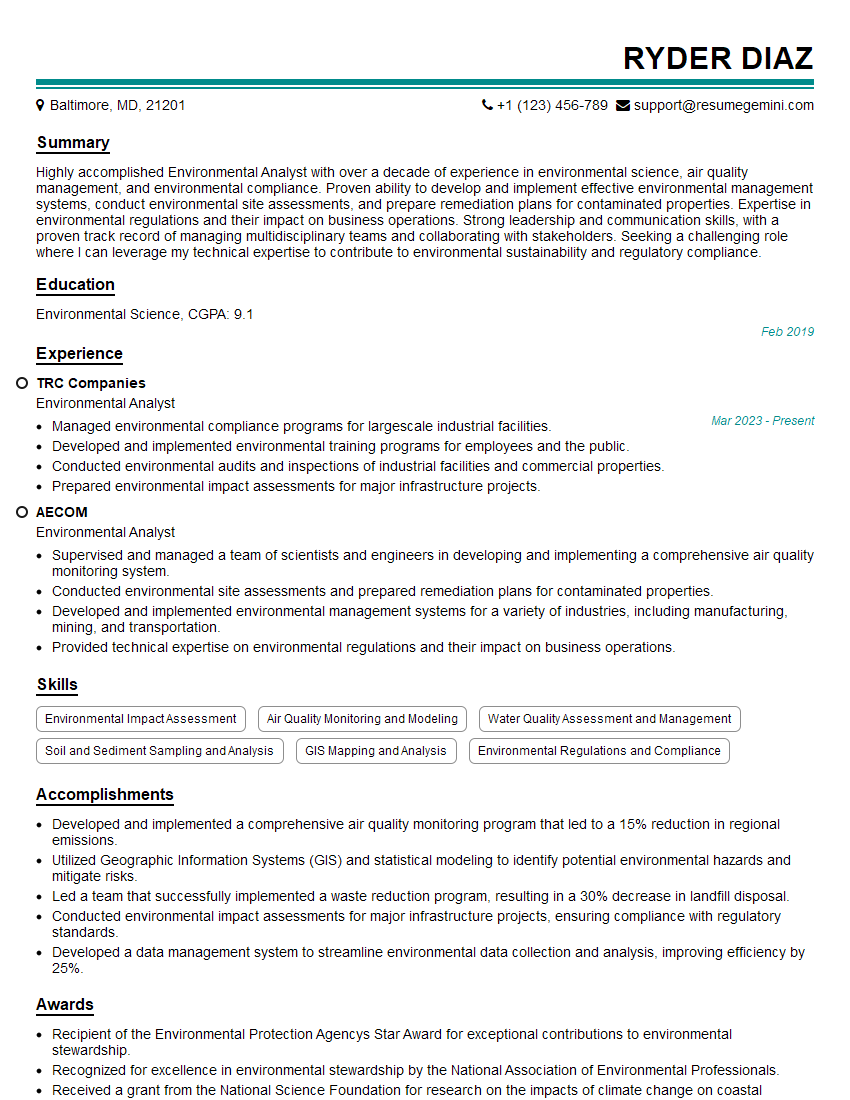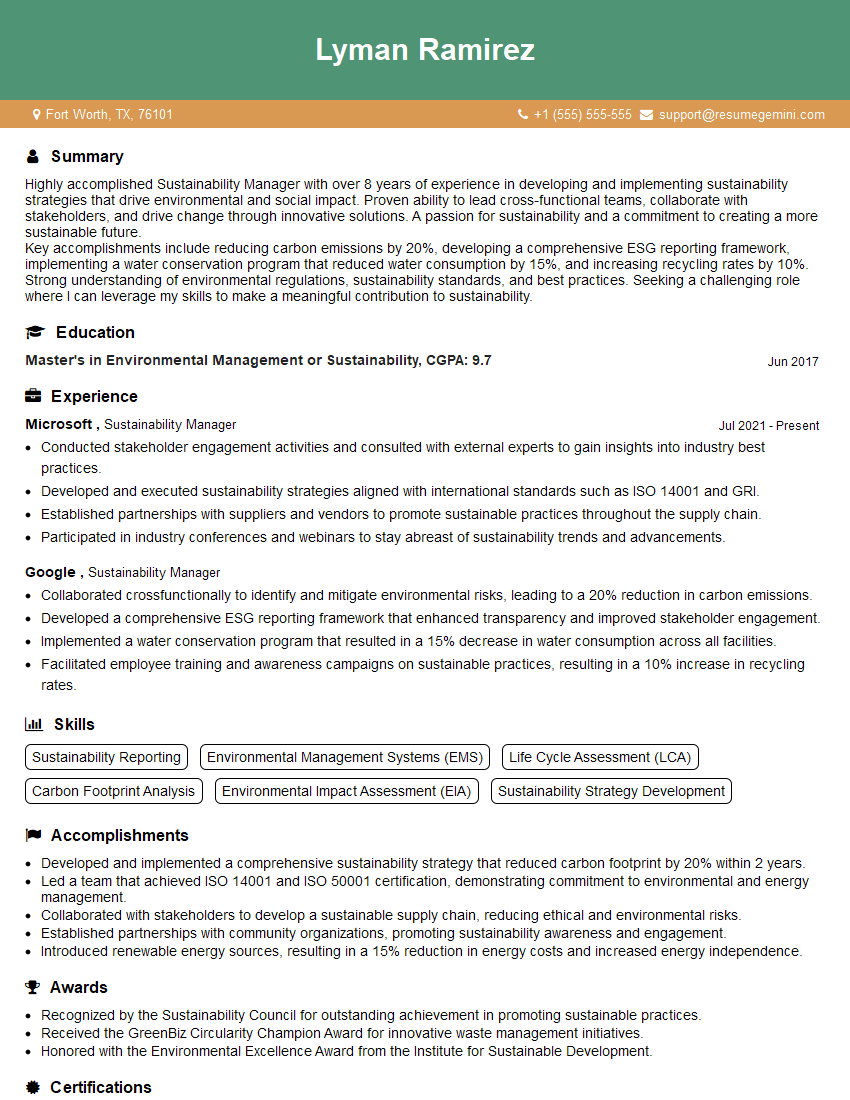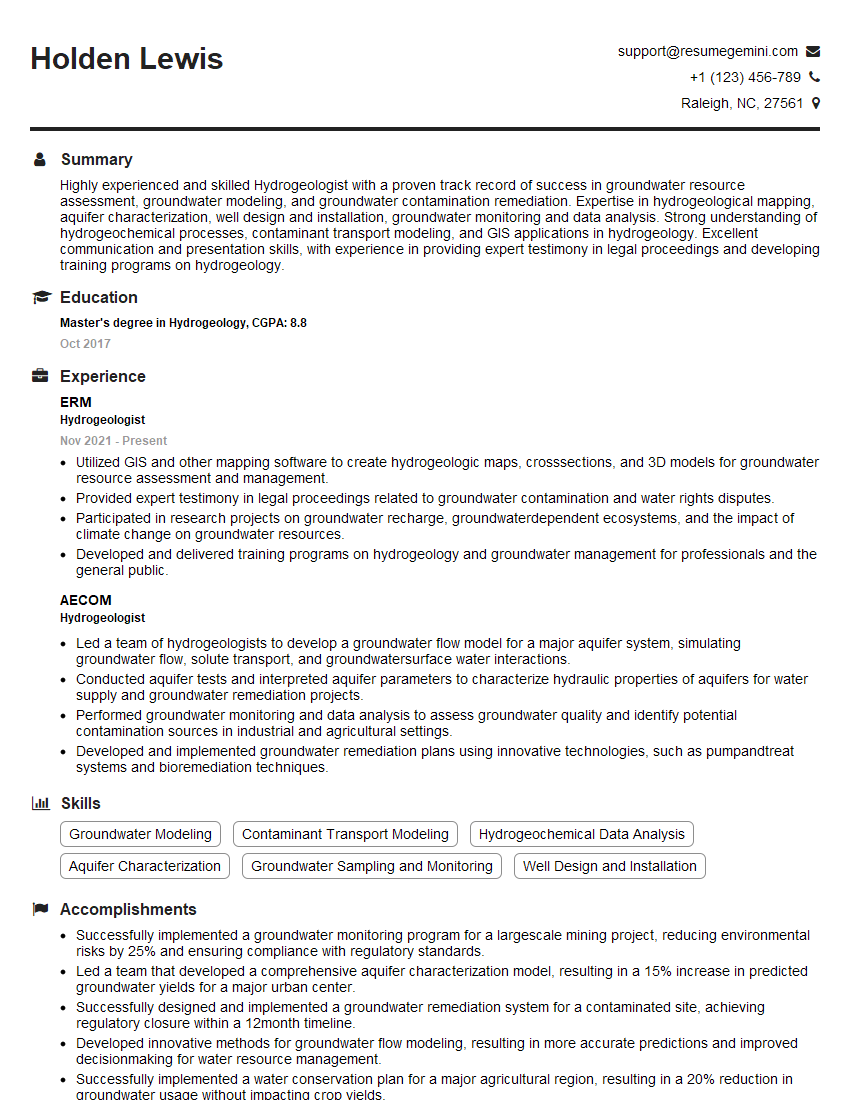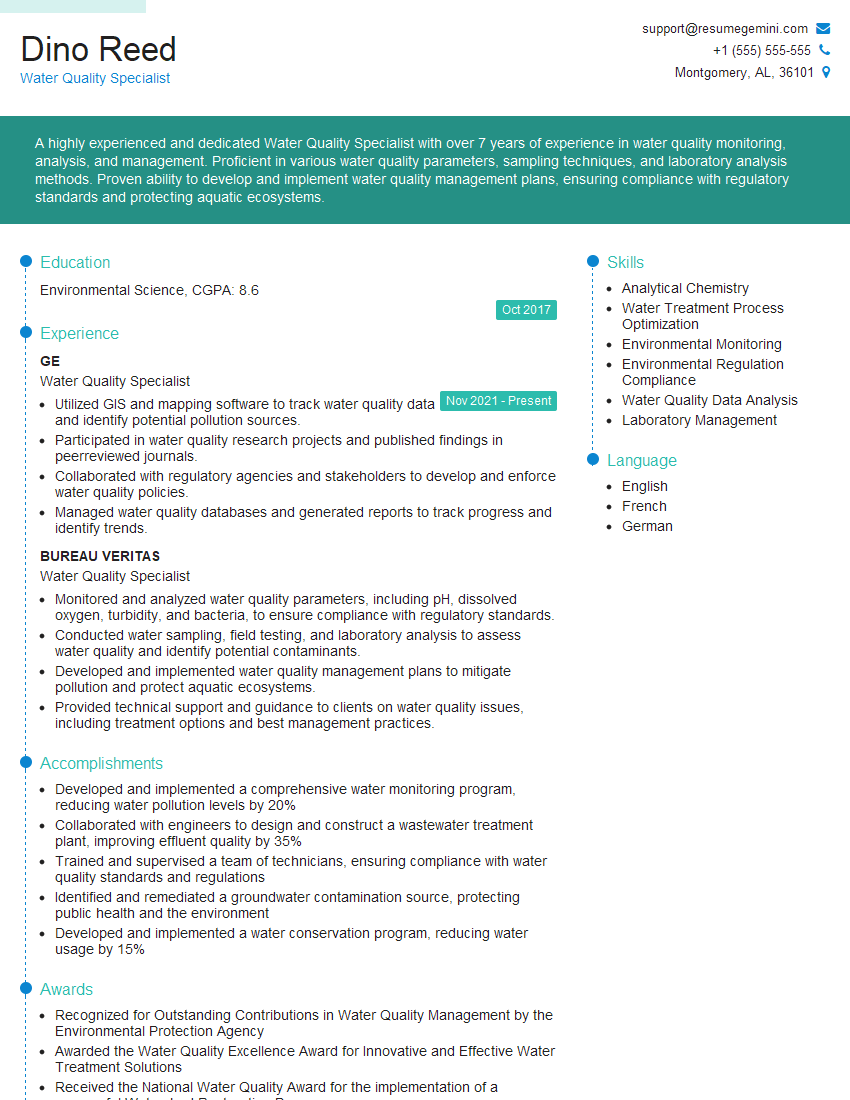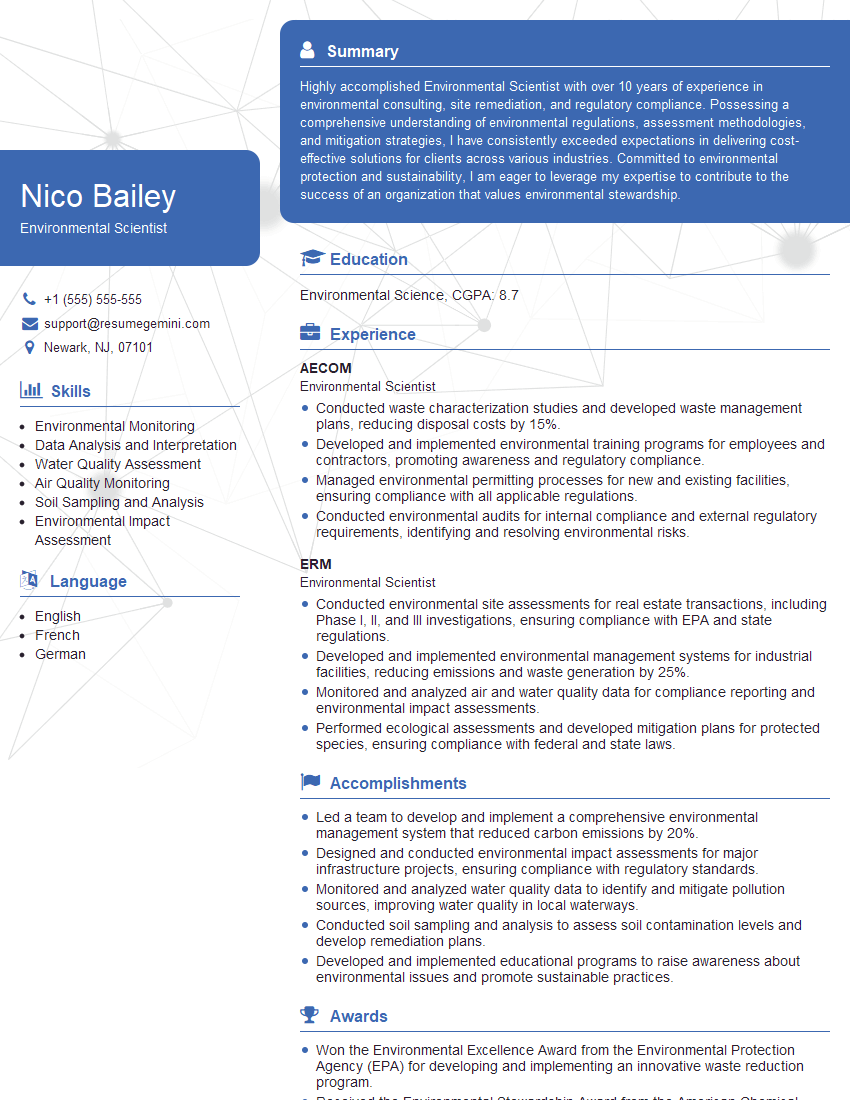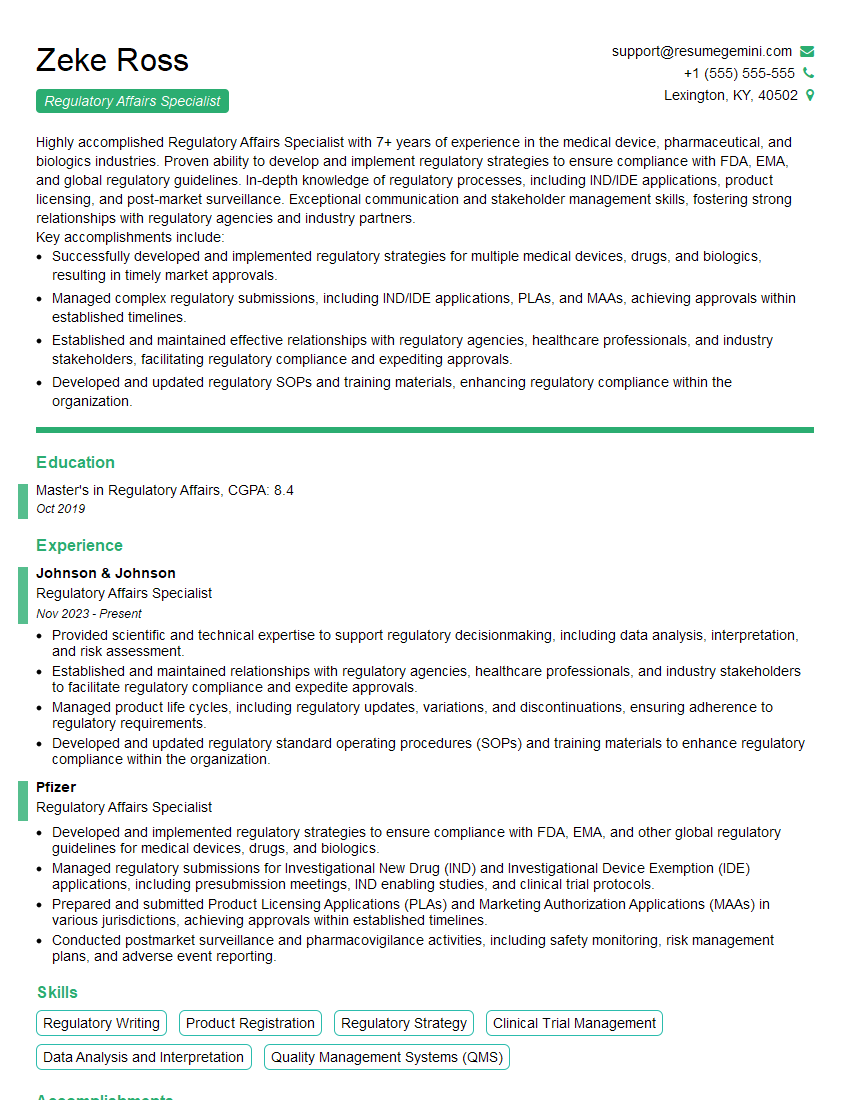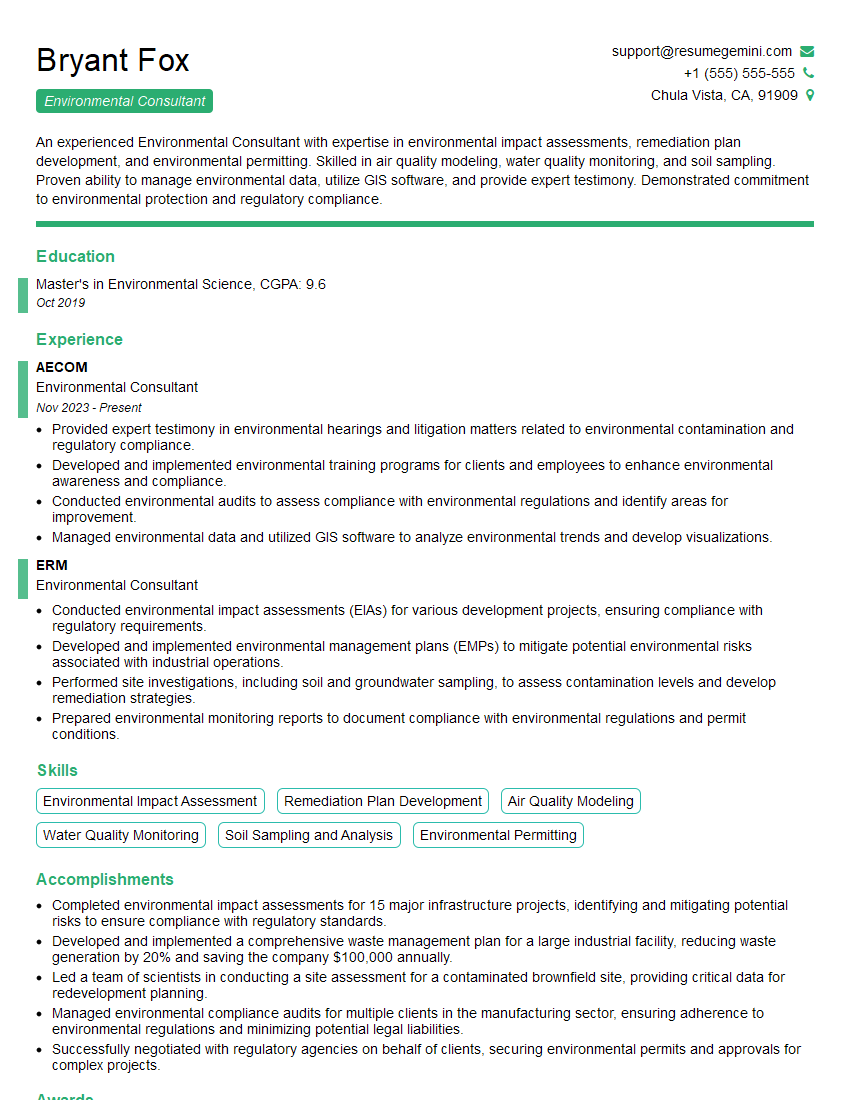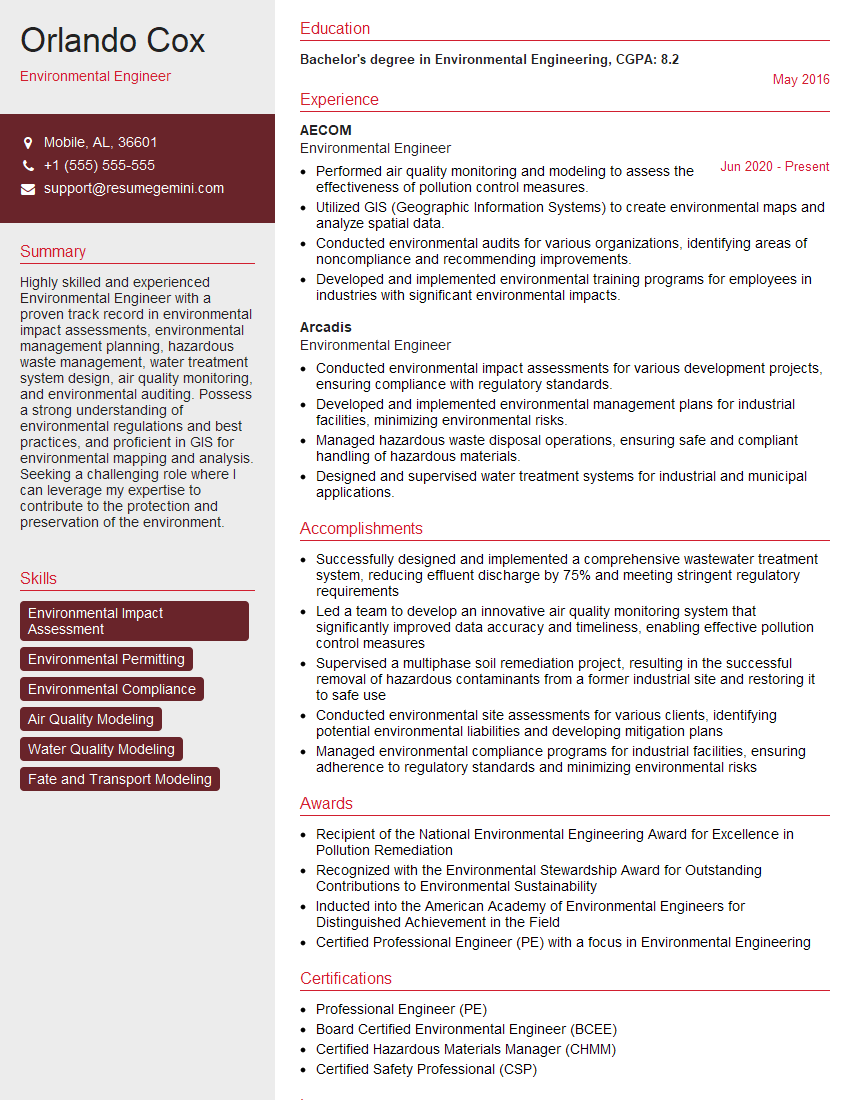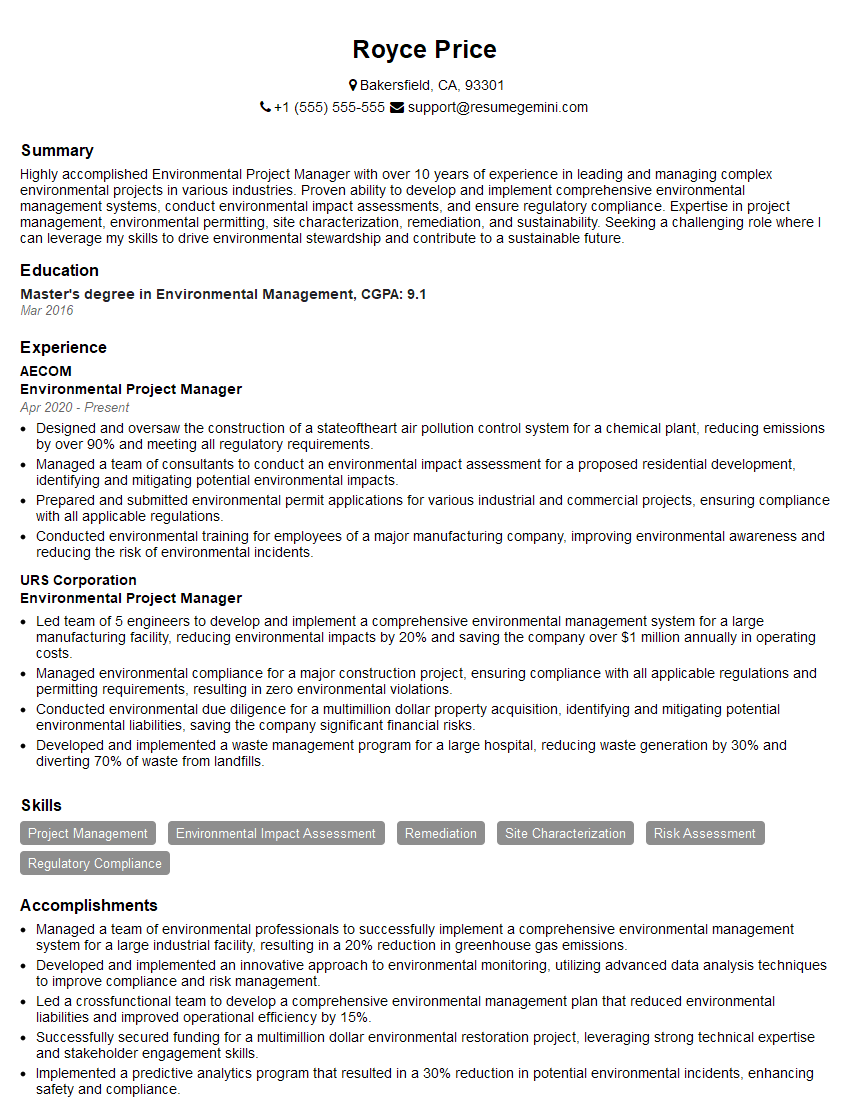Unlock your full potential by mastering the most common Environmental Monitoring and Sampling Protocols interview questions. This blog offers a deep dive into the critical topics, ensuring you’re not only prepared to answer but to excel. With these insights, you’ll approach your interview with clarity and confidence.
Questions Asked in Environmental Monitoring and Sampling Protocols Interview
Q 1. Describe the different types of environmental sampling techniques.
Environmental sampling techniques vary widely depending on the medium (air, water, soil) and the contaminant of interest. Think of it like a detective choosing the right tool for the job – you wouldn’t use a magnifying glass to search for a lost car! Here are some key methods:
- Water Sampling: This includes grab sampling (a single sample at a specific point in time), composite sampling (combining multiple samples), and continuous monitoring (using automated sensors). For example, grab samples are useful for assessing immediate contamination events, while composite samples provide a better representation of average concentration over time.
- Soil Sampling: Techniques range from simple hand augers for shallow samples to more complex techniques like drilling and core sampling for deeper investigations. The choice depends on the depth and extent of potential contamination. For instance, a construction site might use hand augers for initial screening, whereas a hazardous waste site would necessitate specialized drilling.
- Air Sampling: This involves using specialized equipment like high-volume samplers to collect particulates or passive samplers to collect gaseous contaminants. The method depends heavily on the properties of the air pollutants, whether they’re gases, volatile organic compounds, or particulate matter. A factory monitoring air emissions, for instance, would require different equipment than a study measuring airborne pollen.
- Biota Sampling (Plants & Animals): This involves collecting samples of organisms (plants, fish, invertebrates) to assess the bioaccumulation of contaminants. This method provides insights into the effects of pollution on the ecosystem. For example, analyzing the mercury content in fish helps understand the level of mercury pollution in a water body.
The selection of the appropriate technique requires careful consideration of the specific objectives, the nature of the contaminants, and the characteristics of the environment.
Q 2. Explain the importance of chain of custody in environmental sampling.
Chain of custody (COC) is paramount in environmental sampling. It’s essentially a meticulous record that documents the chronological history of a sample, ensuring its integrity from collection to analysis. Think of it as a detailed detective’s log, preventing any confusion or doubt about a sample’s authenticity. Without it, the results are essentially meaningless.
A complete COC includes details about the sample’s location, time of collection, collector’s name, and any handling or transfer information. Every time the sample changes hands, it’s documented. This process minimizes the risk of sample tampering, substitution, or loss, which could invalidate the entire investigation. A compromised COC can lead to costly legal disputes and invalidate test results. Imagine a lawsuit about groundwater contamination; without a clear COC, proving the source of the contamination would be extremely difficult.
Q 3. How do you ensure the accuracy and precision of environmental sampling results?
Ensuring accuracy and precision in environmental sampling requires a multi-pronged approach, starting even before the sampling process begins. It’s like baking a cake – you need the right ingredients and precise measurements for a perfect result.
- Proper Sampling Design: A well-defined sampling plan specifies the locations, number of samples, and sampling methods. This ensures the data collected is representative of the site.
- Calibration and Maintenance of Equipment: Regular calibration and maintenance of sampling equipment ensures accurate measurements. Imagine using a scale that isn’t calibrated – your results will be off!
- Use of Field Blanks and Trip Blanks: These blanks help identify potential contamination during sampling, transport, or analysis. Field blanks are exposed to the field environment but not the sample itself, detecting possible environmental contamination. Trip blanks are unopened containers transported along with the samples to detect potential contamination during transport.
- Laboratory QA/QC Procedures: The lab must employ rigorous quality control measures including duplicate samples, spike recoveries, and method blanks. This ensures that the analytical results are reliable and accurate.
- Proper Sample Preservation and Handling: Samples must be preserved and stored correctly to prevent degradation or alteration. Certain samples need to be refrigerated, preserved with chemicals, or analyzed immediately after collection.
Combining these approaches minimizes errors and ensures the data obtained reflects the true environmental conditions.
Q 4. What are the key considerations for selecting appropriate sampling locations?
Selecting appropriate sampling locations is crucial, as a poorly chosen location can lead to misleading results. It’s like searching for a lost key – you need to look in the right places! Key considerations include:
- Site Characteristics: Understanding the geology, hydrology, and topography of the site is vital. For example, when sampling for groundwater, you need to consider the direction of groundwater flow and locate wells appropriately. Similarly, in soil sampling, you need to consider the depth of contamination.
- Target Contaminant: The location of the samples should be strategic to target the suspected source or areas most likely affected by the contaminant. For example, downstream locations are usually chosen for water quality monitoring when investigating a potential point source.
- Regulatory Requirements: Environmental regulations often specify sampling locations and frequencies. You need to ensure you meet these requirements to comply with the law.
- Accessibility and Safety: Safety should always be prioritized. Sampling locations should be accessible and safe for personnel. This involves ensuring that appropriate safety equipment is used and that potential hazards are addressed.
- Spatial Variability: Samples should represent the entire area of interest, accounting for potential spatial variation in contaminant concentrations. This often involves using statistical techniques to determine the optimal number and location of samples.
Q 5. Describe your experience with different types of sampling equipment.
My experience encompasses a broad range of sampling equipment, tailored to different environmental matrices and contaminants. I’ve used:
- Water Samplers: These range from simple dippers and bottles for surface water to sophisticated peristaltic pumps and depth integrators for groundwater and various water depths.
- Soil Samplers: I’m proficient with hand augers, split-spoon samplers, and core barrels for collecting soil samples from various depths. The type used depends on the soil type and depth.
- Air Samplers: My experience includes using high-volume air samplers for particulate matter, passive samplers for volatile organic compounds (VOCs), and specialized samplers for gases such as sulfur dioxide or carbon monoxide.
- Specialized Equipment: I’ve also worked with equipment for collecting biological samples, including nets, traps, and corers for sediments. For example, benthic grab samplers for collecting bottom sediments from lakes and rivers.
Proper use and maintenance of this equipment is crucial for reliable data, and I am meticulous in ensuring all equipment is calibrated and functioning correctly before each sampling event.
Q 6. How do you handle contaminated samples?
Handling contaminated samples requires strict adherence to safety protocols to protect both personnel and the environment. This is a critical aspect of environmental monitoring, akin to handling hazardous materials in a laboratory. The key elements are:
- Personal Protective Equipment (PPE): This includes gloves, respirators, protective clothing, and eye protection, depending on the nature of the contaminant. The level of PPE is always dictated by the potential health hazard.
- Decontamination Procedures: Detailed decontamination procedures must be followed after sampling, including cleaning equipment and disposing of waste according to regulations. This typically involves cleaning the equipment with appropriate solvents and disposing of contaminated materials in designated containers.
- Spill Response Plan: A well-defined spill response plan should be in place in case of accidental spills. This ensures that the spill can be contained quickly and safely, minimizing exposure.
- Appropriate Containers and Packaging: Samples must be stored in appropriate containers and sealed properly to prevent leakage. Containers are selected based on the specific contaminants. For example, glass containers are usually avoided for VOC analysis, as VOCs can adsorb to the glass.
- Waste Disposal: Contaminated samples and waste must be disposed of according to local and national regulations to prevent further environmental contamination.
Q 7. What are the common QA/QC procedures used in environmental monitoring?
QA/QC (Quality Assurance/Quality Control) procedures are the backbone of reliable environmental monitoring. They ensure the data generated is trustworthy and represents reality. They’re like the proofreaders and editors for a scientific paper. Common procedures include:
- Field Blanks: As mentioned earlier, these are clean containers processed alongside the samples to check for contamination during field activities.
- Trip Blanks: These are unopened containers transported with the samples to detect contamination during transport.
- Duplicate Samples: Collecting duplicate samples at the same location and time allows for assessment of analytical precision. Analyzing duplicate samples allows us to quantify the analytical variation of the laboratory method.
- Spike/Recovery Samples: Known amounts of a contaminant are added to samples and re-analyzed to determine the accuracy and efficiency of the analytical method. This is a key measure of the accuracy of a method.
- Method Blanks: These are analyzed to check for contamination within the analytical laboratory. They check for laboratory contamination in the chemicals and apparatus used for the analysis.
- Laboratory Control Samples (LCS): These are samples of known concentration prepared in the laboratory and analyzed to assess the performance of the laboratory method.
- Data Validation: A thorough review of the data, including outlier detection and plausibility checks, is essential to ensure data quality. This step is used to check whether the obtained results make sense in the context of the site or the target contaminants.
The specific QA/QC procedures vary depending on the analytical method and the specific project requirements, but consistent application of these principles ensures high-quality, reliable results.
Q 8. Explain the difference between grab sampling and composite sampling.
Grab sampling and composite sampling are two fundamental approaches in environmental monitoring, differing primarily in how samples are collected and analyzed. Grab sampling involves collecting a single sample at a specific time and location, providing a snapshot of conditions at that precise moment. Think of it like taking a single photograph – it captures a moment in time but doesn’t represent the overall picture. Composite sampling, on the other hand, involves collecting multiple individual samples over a specific time period or from different locations, combining them into a single composite sample for analysis. This is analogous to creating a time-lapse video; it provides a more comprehensive representation of conditions over a period, though it sacrifices the detail of individual moments.
Example: Imagine monitoring a river for pollutants. A grab sample might be taken from a specific point on the river at noon on a Tuesday. A composite sample might involve collecting samples from the same point every hour for a 24-hour period, then mixing them to get a representative sample for that entire day. Grab samples are useful for immediate contamination detection while composite samples provide an average condition and are cost-effective for routine monitoring.
Q 9. How do you interpret environmental data and identify trends?
Interpreting environmental data and identifying trends is a crucial aspect of environmental monitoring. It involves a combination of statistical analysis, visualization, and contextual understanding. First, data is cleaned and checked for outliers and errors. Then, descriptive statistics (mean, median, standard deviation) are calculated to summarize the data. Visualizations like graphs and charts (e.g., time series plots, box plots, scatter plots) are created to identify patterns and trends. Statistical methods like regression analysis may be used to model relationships between variables. Finally, the results are interpreted in the context of environmental regulations, historical data, and potential influencing factors like weather patterns or industrial activity.
Example: Analyzing water quality data over several years might reveal a decreasing trend in dissolved oxygen levels, indicating potential issues like eutrophication. Identifying the start of this trend, its rate of decline, and potential contributing factors (e.g., agricultural runoff) are key steps in understanding and addressing the problem.
Q 10. What are the limitations of different sampling methods?
Each sampling method has inherent limitations. Grab sampling’s main limitation is its lack of representativeness; a single sample might not reflect the overall condition, particularly in heterogeneous environments. Composite sampling masks variability – individual high or low values get diluted in the composite, potentially hiding significant events or localized pollution hotspots. Other sampling methods, such as passive sampling (using devices that absorb pollutants over time), also have limitations – some pollutants might not be efficiently absorbed, and the exact timing of pollutant uptake might be uncertain. Spatial limitations also exist; sampling in remote or difficult-to-access areas can be challenging and costly, affecting the representativeness of collected data regardless of the method.
Example: A grab sample taken from a stream after a heavy rainfall might show high levels of sediment but not represent the typical conditions of the stream. A composite sample from a landfill might mask a localized leachate plume. It is crucial to select the appropriate sampling method based on the objectives, and to acknowledge limitations when interpreting the results. Often, a combination of methods is used for a more complete picture.
Q 11. Describe your experience with data analysis software used in environmental monitoring.
Throughout my career, I have extensively utilized various data analysis software for environmental monitoring. My proficiency spans statistical packages like R and SPSS for data manipulation, statistical testing, and visualization. I am also experienced with ArcGIS for spatial data analysis and mapping, which is crucial for understanding pollutant distribution and its relationship with environmental factors. Additionally, I have used dedicated environmental data management software to organize and manage large datasets, ensuring data quality and traceability. Finally, I am familiar with various spreadsheet programs like Excel and Google Sheets for data entry, cleaning and basic calculations. The choice of software always depends on the specific project needs and data type.
Q 12. How do you ensure the safety of yourself and others during environmental sampling?
Safety is paramount during environmental sampling. Before any sampling activity, a comprehensive risk assessment is conducted, identifying potential hazards like hazardous materials, difficult terrain, and wildlife encounters. This assessment guides the development of a site-specific safety plan. Appropriate personal protective equipment (PPE), including gloves, respirators, safety glasses, and protective clothing, is used based on the identified hazards. Team members receive adequate training in safe handling procedures and emergency response. Communication protocols, including buddy systems and reporting procedures, are established and adhered to. Weather conditions are monitored closely, and activities are postponed if conditions pose an unacceptable risk. Following these procedures diligently ensures the well-being of the sampling team and minimizes potential accidents.
Example: While sampling in a landfill, we might wear respirators to protect against airborne particulate matter, safety boots for foot protection and high-visibility clothing to ensure visibility.
Q 13. What are the legal and regulatory requirements for environmental sampling in your area?
The legal and regulatory requirements for environmental sampling vary significantly depending on the location and the type of environment being monitored (air, water, soil). In my area, we are bound by [Insert relevant legislation for your area, e.g., Clean Water Act, Clean Air Act, local environmental regulations]. These regulations dictate sampling frequencies, methods, analytical procedures, and reporting requirements for various parameters. Non-compliance can lead to significant penalties. It is crucial to stay updated on all relevant regulations and ensure that all sampling activities are conducted in accordance with the law. Understanding specific permit requirements and reporting deadlines for discharge or emissions is essential.
Q 14. How do you develop and implement an environmental monitoring plan?
Developing and implementing an environmental monitoring plan is a systematic process. It begins with defining clear objectives and identifying the key environmental parameters to be monitored. Next, a detailed sampling design is created, considering factors such as sampling locations, frequency, method, and sample size. This design must be statistically sound to ensure reliable data and to be able to confidently draw conclusions from the study. The appropriate analytical methods are then selected and validated. The plan should include quality assurance/quality control (QA/QC) measures to ensure data accuracy and reliability, including field blanks and duplicate samples. A detailed schedule outlining the sampling and analysis timeline is established. Finally, data management and reporting protocols are implemented. The effectiveness of the monitoring plan is reviewed regularly, and adjustments are made as needed.
Example: For a construction site, the monitoring plan might include dust sampling near the site boundaries, noise measurements at various locations, and water quality analysis in nearby streams. The plan should specify the exact location of sampling points, frequency of monitoring and details of analysis methods.
Q 15. Explain your experience with different types of environmental matrices (air, water, soil).
My experience encompasses a wide range of environmental matrices, including air, water, and soil. Each requires unique sampling strategies and methodologies.
Air Sampling: I’ve worked extensively with various air sampling techniques, from passive samplers (like diffusive samplers for VOCs) to active samplers (high-volume samplers for particulate matter). For example, I was involved in a project monitoring air quality near a newly constructed industrial plant. We used high-volume samplers to collect particulate matter samples at various distances from the plant, following EPA Method 204. The data collected helped determine the plant’s impact on ambient air quality.
Water Sampling: My water sampling experience includes surface water, groundwater, and wastewater. This involves understanding different sampling depths, flow rates, and the potential for contamination during the process. For instance, I’ve used integrated samplers to collect representative samples from a lake to analyze nutrient levels, and I have experience with grab sampling for immediate analysis of contaminants in a river after a suspected industrial spill. Strict adherence to chain of custody protocols was crucial in both scenarios.
Soil Sampling: Soil sampling demands careful consideration of soil heterogeneity. I’m familiar with various techniques, including grid sampling, stratified random sampling, and composite sampling, depending on the study objectives. A recent project involved assessing the extent of soil contamination at a former industrial site. We employed a grid sampling approach, analyzing for heavy metals using EPA Method 6010B.
Career Expert Tips:
- Ace those interviews! Prepare effectively by reviewing the Top 50 Most Common Interview Questions on ResumeGemini.
- Navigate your job search with confidence! Explore a wide range of Career Tips on ResumeGemini. Learn about common challenges and recommendations to overcome them.
- Craft the perfect resume! Master the Art of Resume Writing with ResumeGemini’s guide. Showcase your unique qualifications and achievements effectively.
- Don’t miss out on holiday savings! Build your dream resume with ResumeGemini’s ATS optimized templates.
Q 16. How do you address discrepancies or inconsistencies in sampling data?
Discrepancies in sampling data are common and require a systematic approach to investigation. The first step is to meticulously review the entire sampling process, from planning and field procedures to laboratory analysis. This includes checking for:
- Field Issues: Incorrect sample location, inadequate preservation, cross-contamination, or improper handling.
- Analytical Issues: Instrument calibration, laboratory errors, and method limitations.
- Data Entry Errors: Human errors in recording data or data transfer.
For example, if a particular sample yields unexpectedly high contaminant levels, we might examine the field data for potential issues like an improperly cleaned sampler or a nearby source of contamination not accounted for in the sampling design. Laboratory results are often verified by comparing duplicates or running additional analyses. If a discrepancy persists after a thorough investigation, the data point might be flagged and potentially excluded from the final analysis, with clear justification in the report. If many results are suspect, the entire sampling program might need to be re-evaluated.
Q 17. What are the challenges in environmental sampling and how do you overcome them?
Environmental sampling presents numerous challenges. Some key challenges include:
- Accessibility: Reaching remote sampling locations can be difficult and time-consuming.
- Sample Heterogeneity: Environmental matrices are rarely uniform, leading to sampling biases unless proper strategies are used.
- Weather Conditions: Extreme weather can disrupt sampling schedules and affect sample integrity.
- Safety Hazards: Sampling sites might expose personnel to hazardous substances, requiring specific safety protocols and personal protective equipment (PPE).
To overcome these challenges, we utilize:
- Proper Planning: Thorough site reconnaissance, risk assessment, and detailed sampling plans are essential.
- Appropriate Sampling Techniques: Selecting the correct sampling methods for each matrix and contaminant is crucial.
- Robust Quality Assurance/Quality Control (QA/QC): Implementing rigorous QA/QC measures (e.g., field blanks, duplicates, spikes) ensures data accuracy and reliability.
- Specialized Equipment and Safety Procedures: Using appropriate equipment (e.g., GPS, specialized samplers) and adhering to strict safety protocols safeguard both personnel and data integrity.
For instance, when sampling in a remote area, we might use GPS technology for precise location tracking and drones for aerial surveys to optimize our efforts. We always prioritize safety, using appropriate PPE and following established safety protocols.
Q 18. Describe your experience with specific regulatory compliance (e.g., EPA, OSHA).
I have extensive experience with various regulatory compliance frameworks, primarily EPA and OSHA regulations. My work has involved ensuring adherence to guidelines for:
- Clean Water Act (CWA): Sampling and analysis of water quality parameters in surface waters and wastewater discharges.
- Clean Air Act (CAA): Monitoring air emissions from industrial sources using EPA-approved methods.
- Resource Conservation and Recovery Act (RCRA): Sampling and analysis of hazardous waste and soil contamination.
- Comprehensive Environmental Response, Compensation, and Liability Act (CERCLA): Site assessments and remediation efforts at contaminated sites.
- OSHA: Implementing safety procedures and complying with occupational health and safety standards during field activities.
My experience includes preparing and submitting reports that meet regulatory requirements, interpreting data within the context of these regulations, and recommending actions based on those interpretations. I understand the importance of proper documentation and record-keeping to demonstrate compliance. For example, in a project involving the assessment of a Superfund site, I ensured that all sampling and analytical activities strictly followed CERCLA guidelines, resulting in a report that satisfied EPA requirements and informed the remediation plan.
Q 19. How familiar are you with different laboratory accreditation standards?
I’m familiar with several laboratory accreditation standards, including ISO/IEC 17025 (General requirements for the competence of testing and calibration laboratories) and NELAP (National Environmental Laboratory Accreditation Program). ISO 17025 outlines the requirements for a laboratory to demonstrate its competence to perform specific tests and calibrations, while NELAP is a specific program in the US that accredits laboratories that perform environmental testing. Understanding these standards is vital for ensuring that the analytical data generated is reliable and defensible. I’ve worked with laboratories accredited to these standards and am adept at interpreting their reports and certificates of analysis to assess the quality of the data produced. This includes reviewing method detection limits, uncertainties, and quality control data to ensure the accuracy and precision of the results.
Q 20. What are the best practices for sample preservation and storage?
Proper sample preservation and storage are critical to maintaining sample integrity and preventing degradation or contamination. The methods employed depend on the analyte of interest and the matrix being analyzed.
- Refrigeration: Many samples, especially water and biological samples, are refrigerated at 4°C to slow down microbial growth and degradation.
- Freezing: Some samples may require freezing at -20°C or lower to prevent changes.
- Acidification: Adding acids (such as nitric acid) can stabilize some metals and prevent precipitation.
- Preservative Additives: Various preservatives are used depending on the target analytes, for example, sodium azide for microbiology samples.
- Storage Containers: The choice of containers is critical. Samples should be stored in clean, inert containers to prevent contamination or reactions. Glass is often preferred for many analyses, while plastic is sometimes used for specific applications.
Detailed chain-of-custody documentation accompanies each sample, tracking its handling, preservation methods, and storage conditions throughout its lifecycle. Failure to adhere to these best practices can invalidate the results and compromise the integrity of the entire sampling program. For example, improper preservation of a water sample containing volatile organic compounds could lead to significant losses of the target analytes before analysis, leading to inaccurate conclusions.
Q 21. Explain the role of field blanks and trip blanks in environmental sampling.
Field blanks and trip blanks are essential quality control (QC) samples used to assess potential contamination introduced during the sampling and transportation process.
Field Blanks: These are samples processed in the field alongside the actual samples but contain only the solvent or medium used for sample collection. They help detect contamination occurring during sampling, such as contamination from the sampler, equipment, or the field environment itself. Imagine a field blank as a ‘control’ sample, which allows us to isolate the possible contamination occurring during the sampling and handling of the sample. This allows a comparison to the actual samples to detect contamination.
Trip Blanks: These are similar to field blanks but are transported to the laboratory along with the samples. Trip blanks help identify any contamination that may have occurred during transport or storage. They are essentially containers of the same solvent used for actual samples that are kept in a similar way and moved identically during transport.
Both field and trip blanks are analyzed alongside the actual samples. Any detectable contaminants in these blanks indicate that contamination occurred during either the field or transportation, affecting the actual sample integrity. The presence of contaminants would necessitate the re-evaluation of the sampling procedure or, in extreme cases, the invalidation of the affected samples. The use of field and trip blanks provides a powerful and effective mechanism to ensure the integrity and validity of environmental sampling data.
Q 22. How do you manage and report environmental data effectively?
Effective environmental data management and reporting involves a systematic approach ensuring data integrity, accessibility, and usability. This begins with meticulous record-keeping during the sampling process, documenting all relevant details such as location, date, time, methodology, and personnel involved. This information is crucial for traceability and auditability.
Next, data is entered into a database, often a GIS (Geographic Information System) coupled with a dedicated environmental data management software. This allows for spatial analysis and visualization of the results. Quality control checks are essential at every stage, including data validation, error detection, and outlier analysis. For example, I often use automated checks to flag improbable values, which are then reviewed manually. Finally, reports are generated using clear and concise language, using visualizations like graphs and maps to present complex data effectively to both technical and non-technical audiences. Data is often summarized using descriptive statistics (mean, median, standard deviation) and presented alongside maps illustrating spatial patterns. I always include a clear statement of uncertainty and limitations of the data and methodologies used.
Q 23. Describe your experience with various environmental monitoring technologies.
My experience spans a wide range of environmental monitoring technologies. I’m proficient in using various instruments for water quality analysis, including multi-parameter probes (measuring pH, dissolved oxygen, conductivity, turbidity), spectrophotometers for nutrient analysis, and automated samplers for continuous water monitoring. For air quality monitoring, I’ve worked extensively with air quality monitoring stations measuring particulate matter, ozone, and other pollutants. I also have experience with acoustic sensors for monitoring noise levels in the environment and remote sensing techniques utilizing satellite imagery and aerial photography for large-scale environmental assessments. For soil analysis, I’m experienced in using techniques such as soil coring, sampling, and laboratory analysis for determining soil properties like nutrient content, heavy metal concentrations, and organic matter.
For example, in a recent project assessing water quality in a river system, we employed automated samplers to collect water samples at predetermined intervals throughout the day, minimizing human error and providing a more comprehensive understanding of the temporal variations in water quality. This data was then analyzed using specialized software to identify potential pollution sources and assess the overall health of the river ecosystem.
Q 24. How do you ensure compliance with relevant health and safety regulations during sampling?
Ensuring compliance with health and safety regulations during sampling is paramount. This involves adhering to all relevant legislation, such as OSHA regulations in the United States or equivalent regulations in other countries. Before any sampling activity, a thorough risk assessment is conducted identifying potential hazards, including chemical exposure, physical hazards, and biological risks. Appropriate personal protective equipment (PPE), such as gloves, safety glasses, respirators, and protective clothing, is selected and used consistently. Furthermore, safety training is provided to all personnel involved in the sampling process, and emergency response plans are established and regularly reviewed. I always ensure that all waste generated during sampling is disposed of properly, following all relevant guidelines. For example, during sampling of potentially contaminated soil, we would ensure that all personnel wear appropriate respirators and protective suits, and the soil samples would be properly packaged and transported to the laboratory to avoid any risk of exposure.
Q 25. What are the ethical considerations in environmental monitoring and sampling?
Ethical considerations are central to environmental monitoring and sampling. Maintaining data integrity and objectivity is crucial; avoiding bias in data collection, analysis, and reporting is essential. This includes transparently documenting all methodologies, including limitations, and accurately reporting findings, even if they contradict expectations. Confidentiality of data, particularly where sensitive information might be involved (e.g., proprietary information of industries being monitored), is also paramount. Respect for the environment is crucial, minimizing the impact of the sampling process itself on the environment being studied. We always aim to use non-destructive or minimally invasive sampling techniques whenever possible. Finally, ensuring open communication and transparency with stakeholders, including the public, is also vital to build trust and promote responsible environmental stewardship.
Q 26. Describe your experience with statistical analysis of environmental data.
Statistical analysis is integral to environmental data interpretation. My experience includes using various statistical methods to analyze environmental data, such as descriptive statistics (mean, median, standard deviation, range) to summarize data; inferential statistics (t-tests, ANOVA, regression analysis) to test hypotheses and draw conclusions; and time series analysis to identify trends and patterns in data collected over time. I’m proficient in using statistical software packages such as R and SPSS to perform these analyses. For example, in a study examining the impact of a particular industrial effluent on water quality, I used regression analysis to determine the relationship between effluent discharge and various water quality parameters, allowing us to quantify the impact of the effluent and predict future conditions. Furthermore, I always consider the limitations of statistical models and the importance of interpreting findings in the context of the broader environmental setting.
Q 27. How would you handle a situation where a sample is compromised or lost?
A compromised or lost sample is a serious issue. The first step involves a thorough investigation into the circumstances surrounding the event—determining what went wrong, the extent of the compromise, and who was involved. Depending on the nature of the compromise (e.g., contamination, damage, loss), a decision is made whether to attempt to salvage the data, if possible (e.g., partial recovery of data from a damaged sample). If the sample cannot be salvaged, a formal chain-of-custody document detailing the incident and the corrective actions is prepared. We may decide to replace the compromised sample by resampling the same location under identical conditions, if feasible. All data related to the compromised sample is carefully documented, highlighting the compromise, and its impact on the overall dataset, is clearly indicated in the final report. The limitations of the data due to the sample compromise are explicitly stated.
Q 28. How do you stay up-to-date with advancements in environmental monitoring techniques?
Staying updated in this rapidly evolving field requires ongoing professional development. I actively participate in professional organizations such as the American Chemical Society and the Society for Environmental Toxicology and Chemistry. I regularly attend conferences and workshops to learn about the latest advancements in monitoring techniques and technologies. I subscribe to relevant scientific journals and regularly review published research papers, which helps me understand new methods and technologies and assess their applicability to my work. Furthermore, I actively participate in online learning platforms and webinars related to environmental monitoring and analysis. Staying current allows me to incorporate best practices and cutting-edge technologies to improve the accuracy, efficiency, and effectiveness of our environmental monitoring programs.
Key Topics to Learn for Environmental Monitoring and Sampling Protocols Interview
- Sampling Design and Strategy: Understanding different sampling techniques (grab, composite, etc.), spatial and temporal considerations, and the impact of sample size on data reliability. Practical application: Designing a sampling plan for a specific pollutant in a river system.
- Quality Assurance/Quality Control (QA/QC): Implementing procedures to ensure data accuracy and reliability, including chain of custody, field blanks, duplicates, and spikes. Practical application: Troubleshooting inconsistencies in field data and identifying potential sources of error.
- Specific Sample Handling and Preservation: Knowing appropriate techniques for various matrices (water, soil, air) to maintain sample integrity before analysis. Practical application: Describing the proper handling and preservation of a soil sample for heavy metal analysis.
- Regulatory Compliance: Familiarity with relevant environmental regulations and reporting requirements (e.g., EPA methods). Practical application: Explaining how sampling protocols adhere to specific environmental regulations.
- Data Analysis and Interpretation: Understanding statistical methods used to analyze environmental data, including descriptive statistics and hypothesis testing. Practical application: Interpreting data to assess compliance with environmental standards or identify pollution trends.
- Health and Safety Protocols: Adherence to safety procedures during field work, including personal protective equipment (PPE) use and hazard communication. Practical application: Describing safety procedures for sampling in a potentially contaminated site.
- Emerging Technologies in Environmental Monitoring: Familiarity with advancements in remote sensing, automated monitoring systems, and advanced analytical techniques. Practical application: Discussing the advantages and limitations of using drones for environmental sampling.
Next Steps
Mastering Environmental Monitoring and Sampling Protocols is crucial for career advancement in this dynamic field. A strong understanding of these principles will significantly enhance your job prospects and allow you to contribute meaningfully to environmental protection efforts. To maximize your chances of landing your dream role, creating an ATS-friendly resume is essential. ResumeGemini is a trusted resource that can help you build a professional and impactful resume tailored to showcase your skills and experience effectively. Examples of resumes specifically designed for professionals in Environmental Monitoring and Sampling Protocols are available through ResumeGemini to help guide you.
Explore more articles
Users Rating of Our Blogs
Share Your Experience
We value your feedback! Please rate our content and share your thoughts (optional).
What Readers Say About Our Blog
Hi, I have something for you and recorded a quick Loom video to show the kind of value I can bring to you.
Even if we don’t work together, I’m confident you’ll take away something valuable and learn a few new ideas.
Here’s the link: https://bit.ly/loom-video-daniel
Would love your thoughts after watching!
– Daniel
This was kind of a unique content I found around the specialized skills. Very helpful questions and good detailed answers.
Very Helpful blog, thank you Interviewgemini team.
